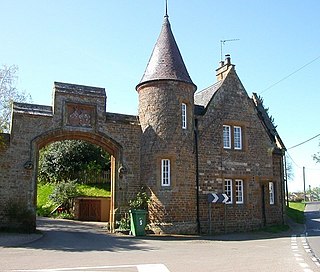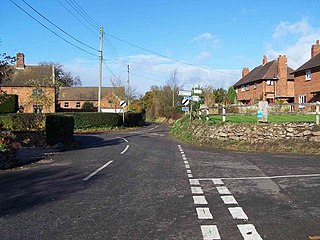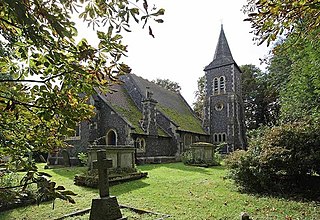
Newport is a market town in the borough of Telford and Wrekin in Shropshire, England. It lies 7 miles (11 km) north-east of Telford town centre, 12 miles (19 km) west of Stafford, and is near the Shropshire-Staffordshire border. The 2001 census recorded 10,814 people living in the town's parish, which rose to 11,387 by the 2011 census.

Condover is a village and civil parish in Shropshire, England. It is about 5 miles (8 km) south of the county town of Shrewsbury, and just east of the A49. The Cound Brook flows through the village on its way from the Stretton Hills to a confluence with the River Severn. Condover is near to the villages of Dorrington, Bayston Hill and Berrington. The population of the Condover parish was estimated as 1,972 for 2008, of which an estimated 659 live in the village of Condover itself. The actual population measured at the 2011 census had fallen to 1,957.

Thorpe Mandeville is a village and civil parish in West Northamptonshire, England about 6 miles (10 km) northeast of Banbury in neighbouring Oxfordshire. The hamlet of Lower Thorpe is just north of the village.

Sulgrave is a village and civil parish in West Northamptonshire, England, about 5 miles (8 km) north of Brackley. The village is just south of a stream that rises in the parish and flows east to join the River Tove, a tributary of the Great Ouse.

Adderley is a village and civil parish in the English county of Shropshire, several kilometres north of Market Drayton. It is known as Eldredelei in the Domesday Book.

Moreton Pinkney is a village and civil parish in West Northamptonshire, about 7.5 miles (12 km) north of Brackley. The 2011 Census recorded the parish's population as 371.

Ightfield is a small village and civil parish in Shropshire, England. The population of the parish at the 2011 census was 529.

Moreton Say is a small village and sparsely populated civil parish in Shropshire, England, near the borders with Cheshire and Staffordshire, just northwest of the town of Market Drayton. It is sometimes spelled Moreton Saye or Moreton Sea. The civil parish, which also covers the hamlets of Longford and Longslow, had a total population of 429 at the 2001 census, increasing to 485 at the 2011 Census. The parish is 5,999 acres.

Stanton upon Hine Heath is a village and parish in Shropshire, England. The River Roden flows through the village.

Shavington cum Gresty is a civil parish in the unitary authority of Cheshire East and the ceremonial county of Cheshire, England. It lies to the south of Crewe. It includes the large village of Shavington, which lies 2+1⁄2 miles south of Crewe, as well as the smaller settlements of Dodds Bank, Park Estate, Puseydale, Sugar Loaf and part of Goodall's Corner. Nearby villages include Basford, Hough, Willaston, Wistaston and Wybunbury. The total population of the civil parish is a little under 5,000.

Arthur Pemberton Heywood-Lonsdale was an English rower and landowner who was High Sheriff of two counties and a substantial investor in North Vancouver.

Shelley is a partly rural village and partly residential conurbation in the Ongar civil parish of the Epping Forest district of Essex, England.

Heywood is a civil parish and small village in the county of Wiltshire in southwestern England. The village is approximately 1.5 miles (2.4 km) north of Westbury and 3.5 miles (5.6 km) south of the county town of Trowbridge.

St Peter's Church is an Anglican church in the village of Adderley, Shropshire, England. It is recorded in the National Heritage List for England as a designated Grade I listed building, The church has a dual function. Its nave and tower form an active parish church in the united benefice of Adderley, Ash, Calverhall, Ightfield and Moreton Say, in the deanery of Hodnet, the archdeaconry of Salop, and the diocese of Lichfield. The chancel and transepts are under the care of The Churches Conservation Trust.
Sir John Corbet, 1st Baronet of Stoke upon Tern was an English politician who represented Shropshire in the House of Commons of the long Parliament. As a moderate Puritan, he was noted before the English Civil War for his campaigns against extra-parliamentary taxation, and for waging a long running dispute over control of his parish church at Adderley which led to his imprisonment. He was a notable member of the Shropshire county committee, responsible for pursuing the war against the royalists. As a part of a Presbyterian middle group in Parliament, he was one of those secluded from parliament by Pride's Purge, and was stripped of his remaining public offices after the Restoration.

Tong or Tong Village is a village and former civil parish in the City of Bradford metropolitan district, West Yorkshire, England. It is a historic village, and gives its name to the larger electoral ward of Tong.

Millichope Park is a 19th-century country house in Munslow, Shropshire, England, some 5 miles (8km) south-east of Church Stretton.
John Pemberton Heywood (1803–1877) was a banker from Liverpool, England, who was High Sheriff of Lancashire in 1855.

Eye, Moreton and Ashton is a civil parish in the county of Herefordshire, England. The parish is 15 miles (24 km) north from the city and county town of Hereford. The closest large town is the market town of Leominster, 3 miles (5 km) to the south. Within the parish is the National Trust property of Berrington Hall, and the villages of Eye, Moreton, and Ashton.



















